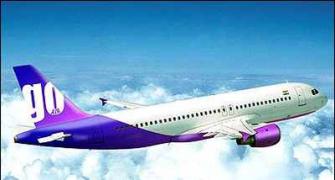 GoAir’s strategy of focussing on markets like Pune, Goa, Chandigarh, Leh and Srinagar is reaping dividends as metro-to-non metro flights are generating over 70 per cent traffic for the low-cost airline.
GoAir’s strategy of focussing on markets like Pune, Goa, Chandigarh, Leh and Srinagar is reaping dividends as metro-to-non metro flights are generating over 70 per cent traffic for the low-cost airline.
The Wadia group-run GoAir was launched in November, 2005.
With just 19 Airbus A320 planes, it has managed to secure 10 per cent market share for the first time in June, partly helped by capacity cuts by rivals in the domestic market.
Between January and May, only GoAir and IndiGo added to their market shares, while other airlines’ shrank.
In June, GoAir’s market share was 10.1 per cent. In Q1 of FY 15, it has been reported to have a profit of Rs 50 crore (Rs 500 million), half of its last reported full-year’s profit in 2012-13.
The focus on non-metro routes, growth in corporate travel and capacity-addition have helped the airline.
Over the last three years, GoAir has spread its wings across non-metro routes that have proved to be lucrative such as Leh and Srinagar, which it connects thrice and six times daily from Delhi, respectively.
Apart from leisure travellers, the Srinagar flights also find traction among defence personnel.
GoAir’s expansion has been a slow and steady affair.
It flies to 21 domestic destinations (SpiceJet and IndiGo fly to 40 and 36 cities, respectively).
GoAir began flying to Kolkata only in November, 2011, and Chennai from May, 2012, and does not serve Hyderabad. Thirteen of its planes are based in Mumbai and Delhi.
“For GoAir the bulk of growth has come from the non-metro cities and towns.
"The airline has a smaller fleet than rivals and cannot match them in frequency and network.
While the Mumbai-Delhi and Mumbai-Bangalore routes are important, the airline has expanded in other markets.
"About 70 per cent of capacity is deployed on such routes and about 73 per cent of its passengers in FY 14 was on these routes," an industry expert says. In the last financial year, the airline added three planes to its fleet, and carried 5.5 million passengers. About 4 million of them took flight on a metro to non-metro route.
On the Delhi-Leh route, the airline began with a thrice-a-week schedule but now has three daily flights.
“We have also started new flights on the Kolkata-Nagpur, Kolkata-Patna and Nagpur-Pune routes.
"The performance on the new routes has been very encouraging, and we have recently doubled our capacity between Kolkata and Nagpur.
"In Q1 of FY 15, we have flown 19 per cent more passengers than Q1 of FY 14. In July, we increased
The other factor fuelling growth for the airline has been the increase in business travellers.
Corporate sales doubled last year, De Roni says.
“The product is simple and clear and fares are competitive," an industry expert adds.
GoAir has a business-class product called GoBusiness and sells only eight seats in the two front rows of its Airbus A320, keeping the middle seats vacant.
The airline is also marketing this product to single women travellers and senior citizens who might require extra attention.
The airline has also hired a consultant to advise it on marketing strategy and branding, and is upgrading its in-flight menu.
Corporate travel plans provide companies with a fixed fare, which is lower than a retail fare, waivers of rebooking and cancellation charges, free on-board meals and preference seating.
Airlines look to increase corporate business as it is not affected by the seasonality of tourist traffic.
“GoAir has grown steadily and has not stretched itself.
"Expansion has remained conservative but this has helped it to remain stable in very trying circumstances.
"Its performance over last three-four years has been creditable, but profitability challenges remain.
"The support from the Wadia Group has been key and crucial for its stability.
"The next one-two years are critical for it as the market dynamics will change structurally. Access to continued and long-term capital flow will be necessary," says Kapil Kaul of Centre for Asia Pacific Aviation.
In 2013-14, GoAir clocked profits less than the Rs 104-crore (Rs 1.04 billion) in 2012-13.
GoAir will receive its 20th Airbus A320 in October.
It earned Rs 2,500 crore (Rs 25 billion) in 2013-14 and is expecting Rs 3,400 crore (Rs 34 billion) this year as it increases its load-factor from about 75 per cent to 80 per cent.
De Roni says that the revenue growth target may be ambitious but “the average fare in July was about 10 per cent year higher than last year”.
GoAir hopes to fly 15 million passengers by 2016-17, serve 30 destinations, up from 21 now, and will remain largely a domestic airline.
EDGE OVER RIVALS
- In the last financial year, GoAir carried 5.5 million passengers, out of which 4 million flew on a metro to non-metro route
- GoAir’s market share increased from 8.4 per cent to 10.1 per cent between January and June. It was one of two airlines to grow market share for five months, till May
- SpiceJet and Jet Airways have reduced capacity in the domestic market









